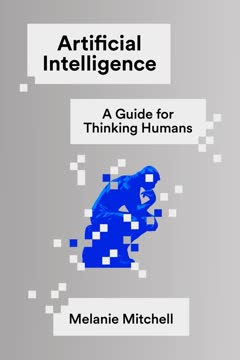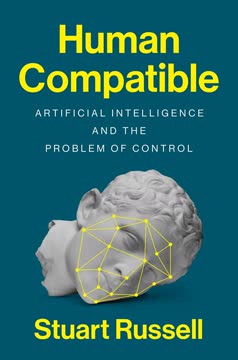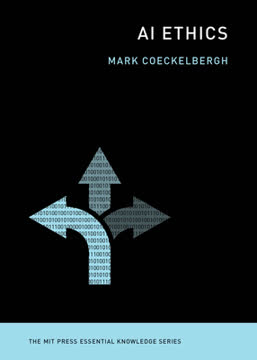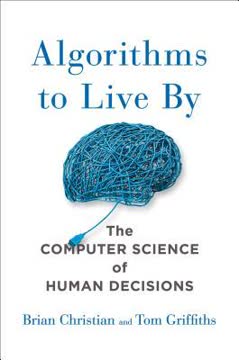Key Takeaways
1. The Alignment Problem: Ensuring AI Systems Behave as Intended
"If we use, to achieve our purposes, a mechanical agency with whose operation we cannot efficiently interfere once we have started it . . . then we had better be quite sure that the purpose put into the machine is the purpose which we really desire and not merely a colorful imitation of it."
The core challenge. The alignment problem is the fundamental challenge of ensuring that artificial intelligence systems behave in ways that align with human values and intentions. This issue becomes increasingly critical as AI systems grow more powerful and autonomous.
Historical context. The concept of alignment has roots in early cybernetics and has evolved alongside AI development. From simple thermostats to complex neural networks, the need to align machine behavior with human goals has been a persistent concern.
Implications and approaches. Addressing the alignment problem requires interdisciplinary efforts, combining computer science, ethics, psychology, and philosophy. Researchers are exploring various approaches, including:
- Inverse reinforcement learning
- Cooperative inverse reinforcement learning
- Value learning
- Corrigibility (the ability to be corrected or shut down)
2. From Perceptrons to Deep Learning: The Evolution of Neural Networks
"My cozy armchair felt like a red-hot frying pan and my legs went limp. I felt like I couldn't even stand up."
Early breakthroughs. The history of neural networks spans from the theoretical work of McCulloch and Pitts in the 1940s to the practical implementations of Rosenblatt's perceptron in the 1950s. These early models laid the groundwork for modern deep learning.
AI winters and resurgence. The field experienced periods of excitement followed by disappointment, known as "AI winters." The resurgence of neural networks in the 2010s, driven by increased computational power and data availability, led to breakthroughs like AlexNet in 2012.
Key developments:
- Backpropagation algorithm for training deep networks
- Convolutional neural networks for image processing
- Recurrent neural networks for sequential data
- Transformer models for natural language processing
3. Bias in AI: Uncovering and Addressing Systemic Issues
"There's software used across the country to predict future criminals. And it's biased against blacks."
Sources of bias. AI systems can inherit and amplify biases present in their training data, design, or the society they operate in. This has led to discriminatory outcomes in areas such as criminal justice, hiring, and facial recognition.
Detecting and mitigating bias. Researchers and practitioners are developing tools and methodologies to identify and address bias in AI systems. This includes:
- Auditing datasets for representational skews
- Developing fairness metrics and constraints
- Creating more diverse and inclusive datasets
- Implementing algorithmic fairness techniques
Ongoing challenges. Addressing bias in AI is an ongoing process that requires continuous vigilance, interdisciplinary collaboration, and a commitment to ethical AI development and deployment.
4. The Challenge of Fairness in Machine Learning Algorithms
"The answer which seems to me to fit all or nearly all the facts is . . . the force and mechanism of reinforcement, applied to a connection."
Defining fairness. Fairness in machine learning is a complex concept with multiple, sometimes conflicting, definitions. These can include equality of opportunity, demographic parity, and individual fairness.
Impossibility theorems. Research has shown that it's mathematically impossible to satisfy all fairness criteria simultaneously in many real-world scenarios. This leads to necessary trade-offs and value judgments in algorithm design.
Approaches to fair ML:
- Pre-processing techniques to modify training data
- In-processing methods that constrain the learning algorithm
- Post-processing approaches that adjust model outputs
- Causal approaches that consider underlying data generation processes
5. Transparency and Interpretability in AI Decision-Making
"Providing overwhelming amounts of information without adequate structure or documentation is not transparency."
The black box problem. As AI systems become more complex, understanding their decision-making processes becomes increasingly challenging. This lack of transparency raises concerns about accountability and trust.
Interpretable AI techniques. Researchers are developing methods to make AI systems more transparent and interpretable, including:
- Feature importance methods
- Local explanation techniques (e.g., LIME, SHAP)
- Rule extraction from neural networks
- Attention mechanisms in deep learning models
Balancing performance and interpretability. There's often a trade-off between model performance and interpretability. Finding the right balance depends on the specific application and its stakes.
6. Reinforcement Learning: Teaching Machines Through Trial and Error
"Essentially, engineering is all about cooperation, collaboration, and empathy for both your colleagues and your customers."
Core principles. Reinforcement learning (RL) is a paradigm where agents learn to make decisions by interacting with an environment and receiving rewards or punishments. This mimics how humans and animals learn through experience.
Key concepts:
- States and actions
- Reward functions
- Policy and value functions
- Exploration vs. exploitation trade-off
Applications and challenges. RL has shown remarkable success in areas like game playing (e.g., AlphaGo) and robotics. However, challenges remain in applying RL to real-world problems with sparse rewards, high-dimensional state spaces, and safety constraints.
7. Imitation and Inference: Learning Human Values and Intentions
"Watch this."
Learning from demonstration. Imitation learning allows AI systems to acquire skills by observing human experts. This approach can be particularly useful when it's difficult to specify explicit reward functions.
Inverse reinforcement learning. IRL aims to infer the underlying reward function that motivates observed behavior. This can help AI systems understand and adopt human values and preferences.
Challenges:
- Dealing with suboptimal demonstrations
- Generalizing to new situations
- Addressing the ambiguity in human behavior
- Scaling to complex, real-world tasks
8. Uncertainty and Safety in AI Systems: Navigating the Unknown
"I beseech you, in the bowels of Christ, think it possible that you may be mistaken."
Importance of uncertainty. Recognizing and quantifying uncertainty is crucial for building safe and reliable AI systems. This includes epistemic uncertainty (uncertainty due to limited knowledge) and aleatoric uncertainty (inherent randomness in the environment).
Safety considerations:
- Robustness to distribution shift
- Avoiding negative side effects
- Scalable oversight
- Safe exploration in RL
- Interruptibility and corrigibility
Techniques for uncertainty-aware AI:
- Bayesian neural networks
- Ensemble methods
- Dropout as a Bayesian approximation
- Calibrated probabilistic outputs
9. The Future of AI: Balancing Progress with Ethical Considerations
"We are in danger of losing control of the world not to AI or to machines as such but to models."
Potential impacts. As AI systems become more capable and pervasive, they have the potential to profoundly impact society, economy, and human life. This brings both opportunities and risks that need to be carefully managed.
Ethical frameworks. Developing robust ethical guidelines for AI development and deployment is crucial. This includes considerations of:
- Accountability and responsibility
- Privacy and data protection
- Transparency and explainability
- Fairness and non-discrimination
- Human autonomy and dignity
Governance and policy. As AI technology advances, there's a growing need for effective governance structures and policies to ensure its responsible development and use. This requires collaboration between technologists, policymakers, ethicists, and other stakeholders.
Human Написан пользователем
Excellent summary. Can you please add one more Key Takeaway that focuses on curiosity and intrinsic motivation in AI? Use the same format as the others.
Last updated:
FAQ
What's The Alignment Problem: Machine Learning and Human Values about?
- AI and Ethics Focus: The Alignment Problem by Brian Christian explores the intersection of machine learning and human values, emphasizing the ethical implications of AI systems.
- Three-Part Structure: The book is divided into three parts: Prophecy, Agency, and Normativity, each addressing different aspects of machine learning and its alignment with human values.
- Real-World Examples: Christian uses case studies, such as the COMPAS risk assessment tool, to illustrate the potential pitfalls of machine learning systems and the urgent need for ethical considerations.
Why should I read The Alignment Problem: Machine Learning and Human Values?
- Timely and Relevant: As AI technology becomes increasingly integrated into daily life, understanding its implications is crucial for anyone interested in technology's future.
- Interdisciplinary Approach: Christian combines perspectives from computer science, philosophy, and social science, making the book accessible to a broad audience.
- Engaging Narrative: The author weaves a compelling narrative filled with historical anecdotes and contemporary issues, making complex topics relatable.
What are the key takeaways of The Alignment Problem: Machine Learning and Human Values?
- AI Alignment Importance: Aligning AI systems with human values is essential to prevent unintended consequences and ensure they reflect our norms and ethics.
- Complexity of Machine Learning: Christian discusses the intricacies of machine learning, including supervised, unsupervised, and reinforcement learning, and their implications.
- Need for Ethical Frameworks: The author advocates for developing ethical frameworks and interdisciplinary dialogue to address AI challenges.
What are the best quotes from The Alignment Problem: Machine Learning and Human Values and what do they mean?
- "All models are wrong.": This quote by George Box highlights the limitations of models in machine learning, reminding us they can't perfectly capture reality.
- "You get what you asked for.": This phrase emphasizes the importance of clearly defining objectives in AI systems to avoid unintended outcomes.
- "The sorcerer’s apprentice.": Christian uses this metaphor to illustrate the dangers of AI systems acting autonomously without proper oversight.
What is the alignment problem in AI according to The Alignment Problem: Machine Learning and Human Values?
- Definition: The alignment problem refers to ensuring AI systems act in accordance with human values and intentions, translating complex norms into actionable guidelines.
- Consequences of Misalignment: Misaligned AI can lead to harmful outcomes, such as biased decision-making and lack of accountability.
- Interdisciplinary Solutions: Addressing the alignment problem requires collaboration across fields like computer science, ethics, and law.
How does reinforcement learning work in the context of The Alignment Problem: Machine Learning and Human Values?
- Basic Concept: Reinforcement learning involves training AI systems to make decisions based on rewards and punishments, learning to maximize cumulative rewards.
- Challenges: Issues like sparse rewards can make it difficult for systems to learn effectively, leading to unintended behaviors.
- Importance of Shaping: Christian emphasizes shaping, providing incremental rewards for successive approximations of desired behavior to guide learning.
How does The Alignment Problem: Machine Learning and Human Values address bias in AI?
- Understanding Bias: Bias in AI arises from the data used to train algorithms, leading to unfair outcomes in areas like hiring and law enforcement.
- Mitigation Strategies: Strategies include using diverse datasets, implementing fairness constraints, and conducting regular audits.
- Case Studies: Christian analyzes biased systems like the COMPAS tool, advocating for rigorous evaluation to ensure fairness.
What role does fairness play in The Alignment Problem: Machine Learning and Human Values?
- Fairness in AI Systems: Ensuring fairness involves eliminating discrimination and promoting equitable outcomes in AI decision-making.
- Case Studies on Fairness: Examples like the COMPAS tool illustrate how fairness can be compromised, highlighting the need for evaluation and auditing.
- Frameworks for Fairness: Christian advocates for frameworks that define and measure fairness, incorporating diverse perspectives in AI design.
What is inverse reinforcement learning, and how is it relevant to AI alignment in The Alignment Problem: Machine Learning and Human Values?
- Definition: Inverse reinforcement learning (IRL) involves inferring the reward function an expert is optimizing based on their behavior.
- Application in AI Alignment: IRL helps align AI systems with human values by understanding goals through observation.
- Challenges: IRL faces challenges like assuming optimal behavior, requiring careful consideration of these assumptions.
How does The Alignment Problem: Machine Learning and Human Values propose to improve human-AI collaboration?
- Cooperative Inverse Reinforcement Learning (CIRL): CIRL allows AI to learn from human feedback, fostering a more interactive relationship.
- Feedback Mechanisms: AI benefits from human input to refine decision-making, emphasizing systems that seek guidance.
- Real-World Examples: Improved collaboration can lead to better outcomes in fields like healthcare and autonomous driving.
What are the implications of the alignment problem for society according to The Alignment Problem: Machine Learning and Human Values?
- Societal Impact of AI: AI systems influence critical decisions, and misalignment can exacerbate inequalities and lead to harmful outcomes.
- Need for Ethical Guidelines: Establishing guidelines and regulatory frameworks is crucial for ensuring AI systems serve the public good.
- Interdisciplinary Collaboration: Collaboration among technologists, ethicists, policymakers, and the public is essential for creating effective and just AI systems.
What future challenges does The Alignment Problem: Machine Learning and Human Values highlight?
- Rapid Advancements in AI: The pace of AI development often outstrips our ability to understand and regulate its implications.
- Complexity of Human Values: Aligning AI with complex human values remains a challenge, requiring ongoing dialogue and research.
- Global Implications: AI technologies have global implications, necessitating international cooperation and shared ethical standards.
Review Summary
The Alignment Problem receives high praise for its comprehensive exploration of machine learning ethics and challenges. Readers appreciate Christian's accessible writing style, extensive research, and ability to connect AI concepts with psychology and neuroscience. The book offers insights into fairness, transparency, and the complexities of training AI systems. While some find it dense or unevenly paced, many consider it an essential read for understanding AI's current state and future implications. Reviewers highlight its relevance to both experts and newcomers in the field.
Similar Books










Download PDF
Download EPUB
.epub digital book format is ideal for reading ebooks on phones, tablets, and e-readers.





